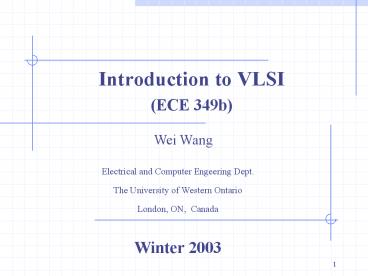Introduction to VLSI (ECE 349b) - PowerPoint PPT Presentation
Title:
Introduction to VLSI (ECE 349b)
Description:
(ECE 349b) Wei Wang. Electrical and Computer Engeering Dept. ... Exponential improvement in technology is a natural trend: steam engines, dynamos, automobiles. ... – PowerPoint PPT presentation
Number of Views:48
Avg rating:3.0/5.0
Title: Introduction to VLSI (ECE 349b)
1
Introduction to VLSI(ECE 349b)
Wei Wang
- Electrical and Computer Engeering Dept.
- The University of Western Ontario
- London, ON, Canada
- Winter 2003
2
- Lecture 1
- Course Introduction
- Jan. 6 2003
3
General
- 1. Welcome remark
- Definition of VLSI
- Importance of VLSI
4
Course Requirement
- Expectations
- Academic industry
- Rules
- Attendance Assignment
- Lab
- Midterm final
5
Information
- Text book in library
- Call no. TK7874.65.W65 2002
- Class notes and lab manual
- Ftp sun30.engga.uwo.ca
- Username ece480a
- Password ec.48.EC
6
Information (contd)
- Labs
- 2 UNIX labs EC 2135 (Weeks of Feb. 4 and 18)
- Two PC labs EC1000 (Weeks of Mar. 4 and 18)
- (Tuesday, Wednesday and Thursday morning)
- Assignments
- Two weeks from the post date
- Drop-off box in front of lab
7
Wei Wang
- Office EC 1006
- Office hours Monday and Wednesday
- 200 to 300 pm
- Email wwang_at_eng.uwo.ca
8
Overview
- Why VLSI?
- Moores Law.
- ASIC Abstraction and Hierarchy.
- FPGA cheaper ASIC
9
VLSI and you
- Microprocessors
- personal computers
- microcontrollers.
- DRAM/SRAM.
- Special-purpose processors.
- Many other applications telecom, DSP,etc.
10
Moores Law
- Gordon Moore co-founder of Intel.
- Predicted that number of transistors per chip
would grow exponentially (double every 18
months). - Exponential improvement in technology is a
natural trend steam engines, dynamos,
automobiles.
11
Moores Law plot
12
- Lecture 2
- Overview of VLSI
- Jan. 8 2003
13
Overview
- Why VLSI?
- Moores Law.
- ASIC Abstraction and Hierarchy.
- FPGA cheaper ASIC
14
ASIC and FPGA
- Application-specific integrated circuit design
- Field programmable gate array
- ASIC 2 UNIX labs (our main focus)
- FPGA 2 PC labs
15
ASIC
- Top-down approaches
16
Levels of abstraction
- Specification function, cost, etc.
- Architecture large blocks.
- Logic gates registers.
- Circuits transistor sizes for speed, power.
- Layout determines parasitics.
17
Design abstractions
specification
behavior
register- transfer
logic
circuit
layout
18
CAD Tools
specification
behavior
register- transfer
logic
circuit
layout
19
ASIC Hierarchical name
- Interior view of a component
- components and wires that make it up.
- Exterior view of a component type
- body
- pins.
cout
Full adder
sum
a
b
cin
20
ASICInstantiating component types
- Each instance has its own name
- add1 (type full adder)
- add2 (type full adder).
- Each instance is a separate copy of the type
cout
Add2(Full adder)
Add1(Full adder)
sum
sum
a
a
b
b
cin
cin
21
Net lists and component lists
- Net list
- net1 top.in1 in1.in
- net2 i1.out xxx.B
- topin1 top.n1 xxx.xin1
- topin2 top.n2 xxx.xin2
- botin1 top.n3 xxx.xin3
- net3 xxx.out i2.in
- outnet i2.out top.out
- Component list
- top in1net1 n1topin1 n2topin2 n3topine
outoutnet - i1 innet1 outnet2
- xxx xin1topin1 xin2topin2 xin3botin1 Bnet2
outnet3 - i2 innet3 outoutnet
22
Component hierarchy
top
i1
xxx
i2
23
Hierarchical names
- Typical hierarchical name
- top/i1.foo
component
pin
24
Layout and its abstractions
- Layout for dynamic latch
25
Stick diagram
26
Transistor schematic
27
Mixed schematic
inverter
28
- Lecture 3
- Overview of VLSI (contd)
- Jan. 10 2003
29
Overview
- Why VLSI?
- Moores Law.
- ASIC Abstraction and Hierarchy.
- FPGA cheaper ASIC
30
Characteristics of ASIC
- Expensive
- Many cycles of design Simulation, synthesis
- Design for testing (DFT)
31
(No Transcript)
32
Layout of ASIC
Pentium IV Technology 0.13 um Area 35
mm square Speed 2.2GHz Power 55 W
33
Design abstractions
specification
behavior
register- transfer
logic
circuit
layout
34
CAD Tools
specification
behavior
register- transfer
logic
circuit
layout
35
Characteristics of FPGA
- Programmability
- Simulation, synthesis
- Test
36
(No Transcript)
37
Layout of FPGA
38
Top-down vs. bottom-up design
- Top-down design adds functional detail.
- Create lower levels of abstraction from upper
levels. - Bottom-up design creates abstractions from
low-level behavior. - Good design needs both top-down and bottom-up
efforts.
39
Design abstractions
specification
behavior
register- transfer
logic
circuit
layout
40
CAD Tools
specification
behavior
register- transfer
logic
circuit
layout
41
Contents of the Course
- ASIC FPGA
- Transistor and Layout
- Gate and Schematic
- Systems and VHDL/Verilog
42
Contents of the Course (contd)
- 2 ASIC labs 2 FPGA labs
- Transistor/Layout
- Gate and Schematic
- Systems/VHDL
(Cadence)
(Xilinx Foundation)
(Synopsys)
43
The Future Is Not What It Used To Be
44
Future of VLSI
- Nanotechnology
- Biotechnology
- Information technology
45
(No Transcript)































